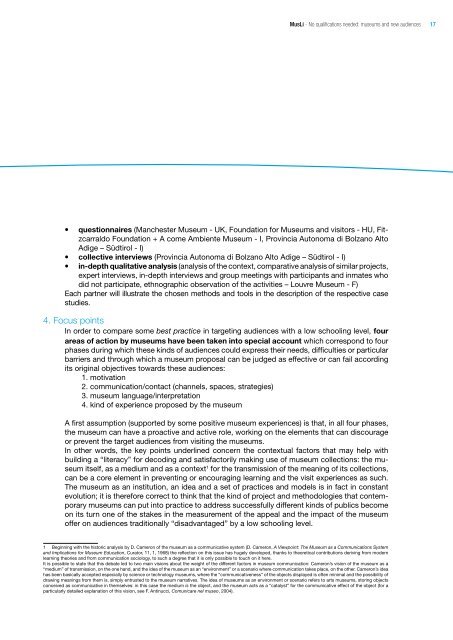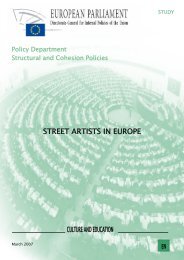MusLi (Museums Literacy) - Fondazione Fitzcarraldo
MusLi (Museums Literacy) - Fondazione Fitzcarraldo
MusLi (Museums Literacy) - Fondazione Fitzcarraldo
You also want an ePaper? Increase the reach of your titles
YUMPU automatically turns print PDFs into web optimized ePapers that Google loves.
<strong>MusLi</strong> - No qualifications needed: museums and new audiences<br />
• questionnaires (Manchester Museum - UK, Foundation for <strong>Museums</strong> and visitors - HU, <strong>Fitzcarraldo</strong><br />
Foundation + A come Ambiente Museum - I, Provincia Autonoma di Bolzano Alto<br />
Adige – Südtirol - I)<br />
• collective interviews (Provincia Autonoma di Bolzano Alto Adige – Südtirol - I)<br />
• in-depth qualitative analysis (analysis of the context, comparative analysis of similar projects,<br />
expert interviews, in-depth interviews and group meetings with participants and inmates who<br />
did not participate, ethnographic observation of the activities – Louvre Museum - F)<br />
Each partner will illustrate the chosen methods and tools in the description of the respective case<br />
studies.<br />
4. Focus points<br />
In order to compare some best practice in targeting audiences with a low schooling level, four<br />
areas of action by museums have been taken into special account which correspond to four<br />
phases during which these kinds of audiences could express their needs, difficulties or particular<br />
barriers and through which a museum proposal can be judged as effective or can fail according<br />
its original objectives towards these audiences:<br />
1. motivation<br />
2. communication/contact (channels, spaces, strategies)<br />
3. museum language/interpretation<br />
4. kind of experience proposed by the museum<br />
A first assumption (supported by some positive museum experiences) is that, in all four phases,<br />
the museum can have a proactive and active role, working on the elements that can discourage<br />
or prevent the target audiences from visiting the museums.<br />
In other words, the key points underlined concern the contextual factors that may help with<br />
building a “literacy” for decoding and satisfactorily making use of museum collections: the museum<br />
itself, as a medium and as a context 1 for the transmission of the meaning of its collections,<br />
can be a core element in preventing or encouraging learning and the visit experiences as such.<br />
The museum as an institution, an idea and a set of practices and models is in fact in constant<br />
evolution; it is therefore correct to think that the kind of project and methodologies that contemporary<br />
museums can put into practice to address successfully different kinds of publics become<br />
on its turn one of the stakes in the measurement of the appeal and the impact of the museum<br />
offer on audiences traditionally “disadvantaged” by a low schooling level.<br />
1 Beginning with the historic analysis by D. Cameron of the museum as a communicative system (D. Cameron, A Viewpoint: The Museum as a Communications System<br />
and Implications for Museum Education, Curator, 11, 1, 1968) the reflection on this issue has hugely developed, thanks to theoretical contributions deriving from modern<br />
learning theories and from communication sociology, to such a degree that it is only possible to touch on it here.<br />
It is possible to state that this debate led to two main visions about the weight of the different factors in museum communication: Cameron’s vision of the museum as a<br />
“medium” of transmission, on the one hand, and the idea of the museum as an “environment” or a scenario where communication takes place, on the other. Cameron’s idea<br />
has been basically accepted especially by science or technology museums, where the “communicativeness” of the objects displayed is often minimal and the possibility of<br />
drawing meanings from them is, simply entrusted to the museum narratives. The idea of museums as an environment or scenario refers to arts museums, storing objects<br />
conceived as communicative in themselves: in this case the medium is the object, and the museum acts as a “catalyst” for the communicative effect of the object (for a<br />
particularly detailed explanation of this vision, see F. Antinucci, Comunicare nel museo, 2004).<br />
17






